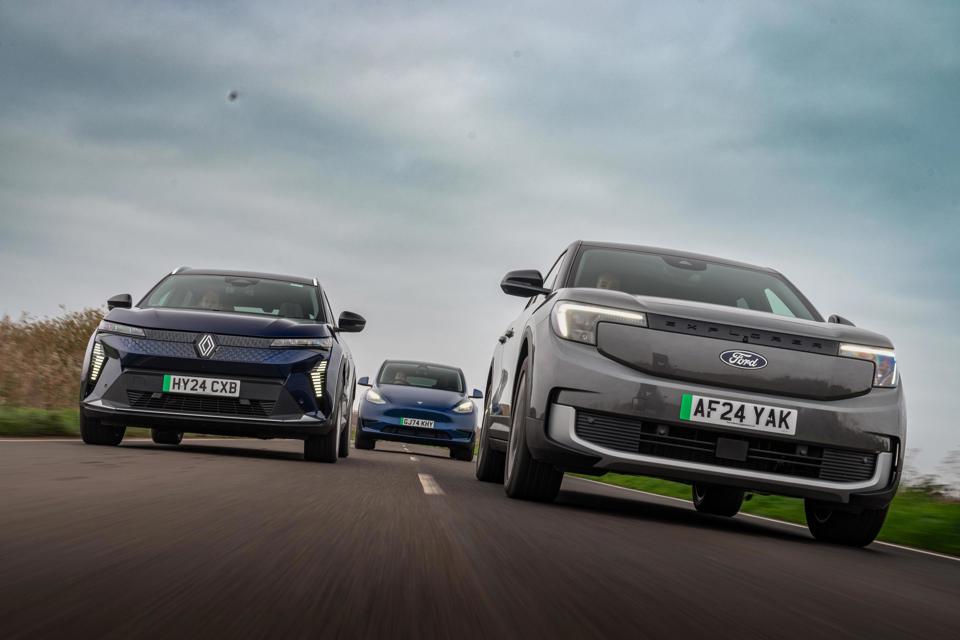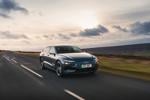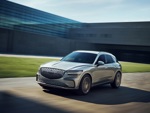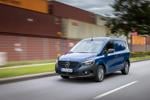The prospect of a 300-mile electric car may have seemed alien a few years ago but now there’s plenty of options for those that want a practical family EV with a long range.
In this test we’re comparing the Ford Explorer Extended Range RWD, Renault Scenic E-Tech Long Range and the Tesla Model Y Long Range RWD.
All three compete in the mid-size SUV segment with price tags of less £50,000 and ranges of more than 350 miles. Add in their 2% benefit-in-kind tax rates and you’ve got a trio of potentially very compelling company car choices.

But which is the most efficient in real world driving?
To find out we drove all three cars on the same route at the same time. We repeated the test loop three times, with a driver swap in between, to rule out any differences in driving style. The cars all started with a full charge, their climate controls set to 21-degrees and the normal driving mode was used throughout. We avoided full throttle acceleration but stuck to the speed limits, which ranged from 30mph urban roads all the way up to motorway sections.
Ford is still having a hard time breaking into the electric vehicle market. The Explorer follows in the footsteps of the Mustang Mach-E, with both models competing in the same segment.
The prospect of a 300-mile electric car may have seemed alien a few years ago but now there’s plenty of options for those that want a practical family EV with a long range.
In this test we’re comparing the Ford Explorer Extended Range RWD, Renault Scenic E-Tech Long Range and the Tesla Model Y Long Range RWD.
All three compete in the mid-size SUV segment with price tags of less £50,000 and ranges of more than 350 miles. Add in their 2% benefit-in-kind tax rates and you’ve got a trio of potentially very compelling company car choices.

But which is the most efficient in real world driving?
To find out we drove all three cars on the same route at the same time. We repeated the test loop three times, with a driver swap in between, to rule out any differences in driving style. The cars all started with a full charge, their climate controls set to 21-degrees and the normal driving mode was used throughout. We avoided full throttle acceleration but stuck to the speed limits, which ranged from 30mph urban roads all the way up to motorway sections.
Ford Explorer RWD Extended Range
- P11d price: £49,920
- Range (WLTP): 354 miles
- Test efficiency: 3.7mi/kWh
Ford is still having a hard time breaking into the electric vehicle market. The Explorer follows in the footsteps of the Mustang Mach-E, with both models competing in the same segment.
The two cars are actually quite different in reality. While the Mustang is Ford through-and-through, the Explorer is re-worked version of the VW ID4. It uses VW’s powertrain, battery and software.
Ford’s makeover extends beyond the Explorer’s exterior to the inside, where the cabin is very different to what you’ll find in an ID4. While VW opted for a minimalist approach, giving an open and minimalist cabin, the Explorer’s cabin has more substance and a premium feel.
Our test model has the longest range available. It uses a 77kWh battery and a rear-mounted 286PS motor. The official range is 354 miles.

The car comes in Premium spec, with a decent array of kit. There’s a 10-speaker B&O stereo, leather upholstery and a panoramic sunroof. You also get a 14.6-inch central touchscreen.
In testing the Explorer impressed with its smooth and stable ride. The car is well insulated and offers a quiet and refined experience. There’s also a playful nature to the car’s handling thanks to its steering which is quick and nicely weighted. The softer suspension setup allows for a bit of body roll but it’s well contained and helps to soak up imperfections in the road.
On our test route the car returned 3.7mi/kWh, suggestion a real-world range figure of 285 miles can be expected.
The Explorer is the most expensive car of the trio, but theoretically has the lowest range. It does support DC rapid charging at up to 135kW, allowing a 10%-80% charge in 28 minutes.
Tesla Model Y Long Range RWD
- P11d price: £46,935
- Range (WLTP): 351 miles
- Test efficiency: 4.1mi/kWh
The Model Y was the best-selling company car in 2023 and 2024. Despite concerns from some fleet managers about the brand’s aftersales and data protection policies, it seems company car drivers simply love the Model Y.
While an updated version is due to launch imminently, the Long Range RWD powertrain will be carried over, having only joined the line-up in late 2024.
It uses a 75kWh battery, which is the smallest of the group, but has the largest power output at 335PS.
The Model Y is therefore the quickest car in our test, managing 0-62mph in less than six seconds. Acceleration is impressive and the car always feels responsive.

With a firm suspension setup the Model Y has a hard ride and is the least comfortable in this test. One upshot is agility. There’s very little body roll, although this is offset by a twitchy steering setup which never relaxes.
Some people love the Model Y’s spartan interior and others hate it. The build quality is questionable, in places, but it is exceptionally spacious. Everything is pretty much controlled via the single central display. Once you’re used to the interface it’s straightforward enough, but a few buttons would be welcome.
We can’t fault the Model Y’s efficiency, however. It managed 4.1mi/kWh, giving a real-world range of 308 miles. In a separate test we did manage 300 miles from a single charge in the car, so we’re confident of its capabilities.
At a Tesla Supercharger, or suitable DC fast charger, the Model Y can charge at up to 250kW. This enables a 10%-80% charge in 27 minutes.
Renault Scenic E-Tech Long Range
- P11d price: £45,440
- Range (WLTP): 379 miles
- Test efficiency: 3.3mi/kWh
With countless awards under its belt already and the lowest list price of our group, the Renault Scenic makes a lot of sense as a company car.
This top-spec Iconic model undercuts both the Explorer and the Model Y, yet it’s the most modern-looking and promises the longest range.
The Scenic’s light and airy interior is cleverly designed. It’s spacious with plenty of practical storage and the rear armrest features built in tablet holders to keep kids entertained.
Its party piece is trick sunroof that turns opaque at the touch of a button, negating the need for a slow and cumbersome electric blind.

The Scenic’s 87kWh battery is the largest here, by quite some margin. That gives an official range of 379 miles.
Power output is modest compared to the other two cars here. The front-wheel-drive Scenic E-Tech has 215PS, which is enough for a sub-eight-second 0-62mph acceleration time. You can feel the power deficit after driving all three cars back-to-back, but the Scenic still doesn’t feel slow.
It rides well, with good refinement and comfort levels. We also really liked the interior design and layout. The central screen uses Google Maps for sat-nav and is really easy to use. There’s a mix of different materials, throughout, giving the car an upmarket feel.
When it comes to efficiency, the Scenic returned a disappointing result. Bearing in mind we drove all three cars in identical conditions, the Scenic only managed 3.3mi/kWh. Because of its giant battery, that’s still enough to secure a theoretical 287-mile range, but also the worse performance of our group.
Charging speeds are slightly faster than the Ford’s, at 150kW, but again because the battery is larger a 10%-80% top up takes 40 minutes.
[gallery id=2053]
Verdict
It’s surprising that three cars that appear to compete so closely on paper returned such disparate results. We were really impressed by the Scenic as an overall package, it’s great looking and excellent value. The car’s design also feels the freshest. But that efficiency result just doesn’t cut it against the Explorer and Model Y. Especially as the Scenic is the least powerful car here.
The Ford looks and feels like a heavy car, and is the only one to tip over 2.0-tonnes. Yet it performed respectably. Of course, the results align with our expectations based on driving the Audi Q4 e-tron, Skoda Enyaq and VW ID4 – as all of them are related.
That leaves the Tesla. Clearly all those company car drivers knew what they were doing because the Model Y eclipsed its rivals in this test. Achieving more than 4.0mi/kWh is impressive in any EV, let alone a high-roof SUV. Sure, there are irritations with the ergonomics, and the ride is pretty awful, but for long-distance driving it’s going to be the easiest to live with.

So, what’s our verdict then? Well, the Scenic still stacks up on price and its real-world range is only 21 miles short of the Tesla’s. It’s a great all-rounder and Renault’s fleet support is going in the right direction.
Ford surprised us the most, with the Explorer. The work done to make it a ‘Ford’ largely makes it a nicer car than the ID4. The cabin is more plush and it drivers really well. Sitting mid-table in our efficiency test is a strong performance, too.
While the Tesla is easily the best-performing EV, everything else about it, excluding boot space, just feels less impressive than the others. Faced with the choice of which to drive home, it’s the Explorer that has the greatest allure.
Photography: Alex Tapley
Login to continue reading.
This article is premium content. To view, please register for free or sign in to read it.




















Login to comment
Comments
No comments have been made yet.